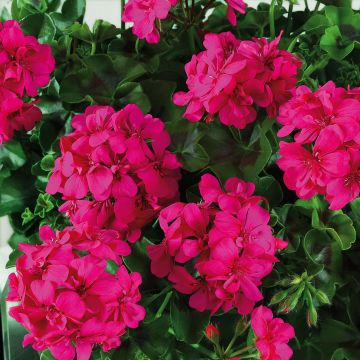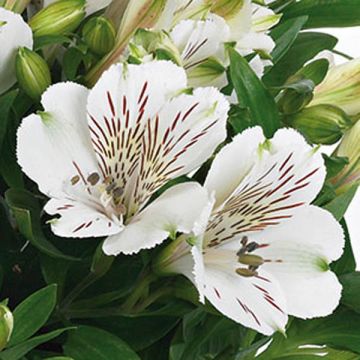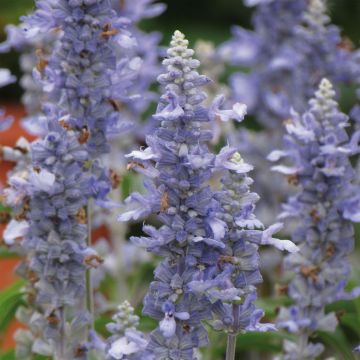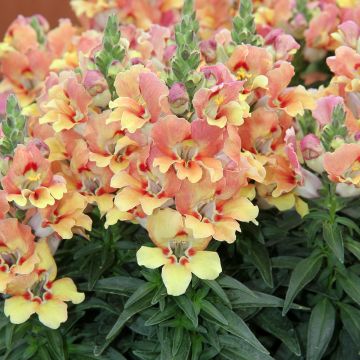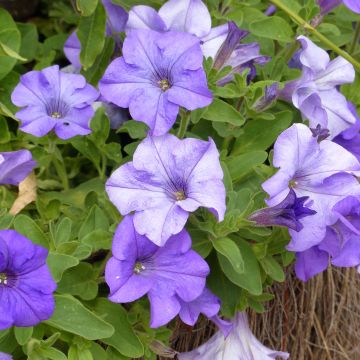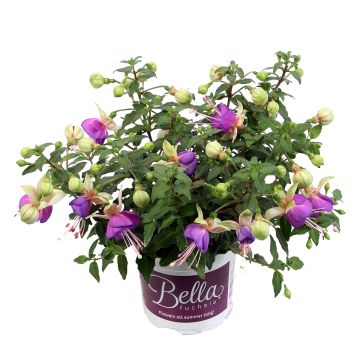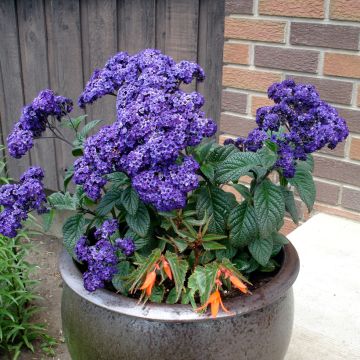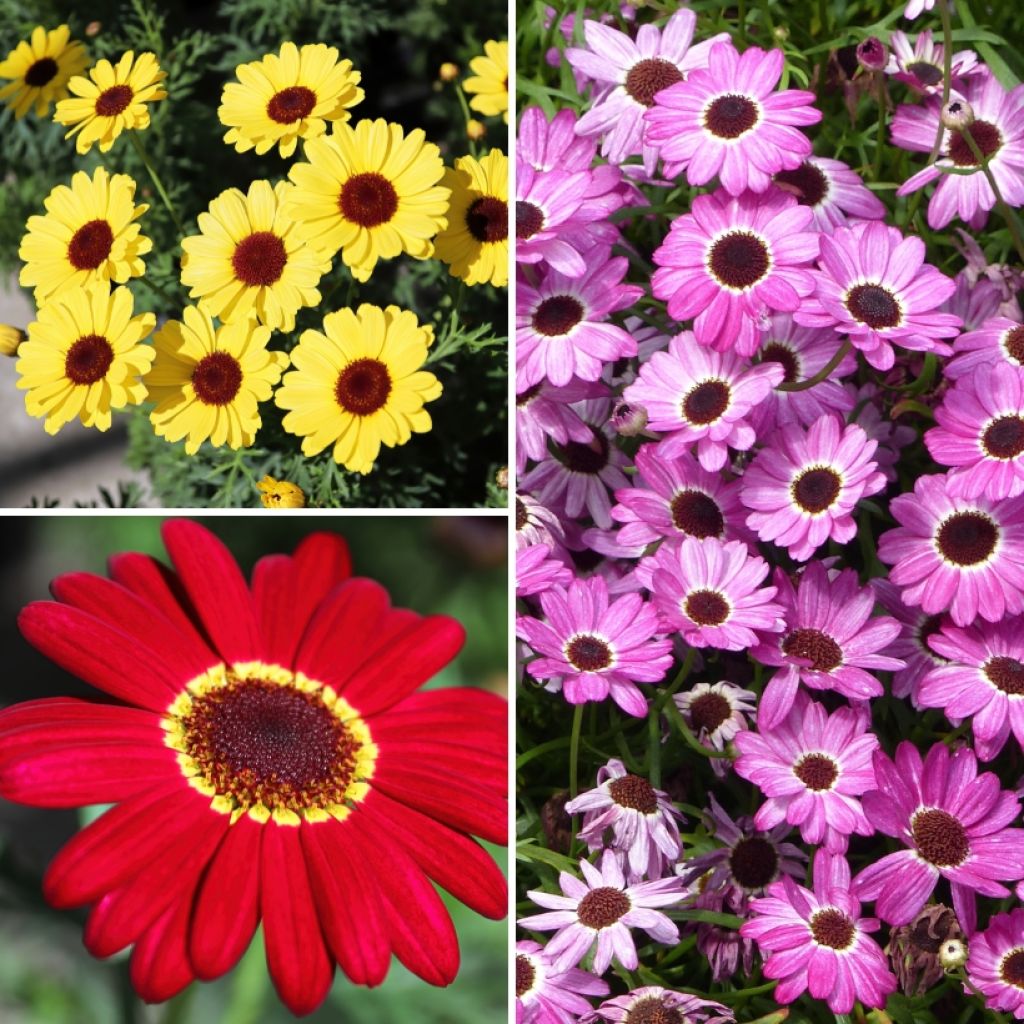

Argyranthemum collection - Marguerite bush
Argyranthemum collection - Marguerite bush
Argyranthemum Grandaisy® Gold, Grandaisy® Ruby, Grandaisy® Pink Tourmaline
Marguerite bush, Paris daisy, Marguerite shrub, Marguerite tree
This item cannot be shipped to the selected country
Delivery charge from €5.90
More information
Schedule delivery date,
and select date in basket
This plant carries a 6 months recovery warranty
More information
We guarantee the quality of our plants for a full growing cycle, and will replace at our expense any plant that fails to recover under normal climatic and planting conditions.
From €5.90 for pickup delivery and €6.90 for home delivery
Express home delivery from €8.90.
Does this plant fit my garden?
Set up your Plantfit profile →
Collection items (5 plants)
Description
This Argyranthemum collection for borders and balconies is an assortment of 3 varieties of Argyranthemum from the Grandaisy series. These recent horticultural hybrids are characterised by brightly coloured 6 cm daisy-like flowers and a real ease of cultivation. They are tender perennials commonly grown as annuals which form small bushes of 50 cm that bloom from May-June to October and require little maintenance. Their stems are highly branched and the finely divided leaves make up abundant, green-blue foliage, aromatic when crushed, and very light in appearance.
The collection consists of:
- 1 Argyranthemum Grandaisy 'Gold': flowers with a bright and contrasting colour, golden yellow with a brown-red centre.
- 2 ArgyranthemumGrandaisy 'Ruby': red flowers with a dark centre finely circled in yellow, extremely bright.
- 2 Argyranthemum Grandaisy 'Pink Tourmaline': flowers combining frosted mauve and pink and an almost black centre with a white ring.
These Grandaisy Argyranthemums are sun lovers and dislike excessive moisture in winter. In frost-free climates, plant them in the ground in spring, in well-drained, slightly acidic, neutral, or chalky soil. Allow 5 plants per square metre. Elsewhere, grow them in large pots that you can overwinter frost-free. 'Grandaisy' Argyranthemums soon form charming, rounded flowery clumps that look stunning mixed with fennel, borage, cosmos, or blue and white love-in-a-mist flowers. They can also be placed in flower beds, rockeries, borders, or along a path in a steep garden. And of course, they offer a fantastic display in flower pots, accompanied by Silver Falls Dichondra, silver basket or dwarf snapdragons, on the terrace or balcony.
Note: Please be aware that our plug plants are products reserved for experienced gardeners: upon receipt, transplant and store them in sheltered areas (veranda, greenhouse, cold frame...) at a temperature above 14°C for a few weeks before being planted outdoors once all risk of frost has passed.
Report an error about the product description
Flowering
Foliage
Plant habit
Botanical data
Argyranthemum
Grandaisy® Gold, Grandaisy® Ruby, Grandaisy® Pink Tourmaline
Asteraceae
Marguerite bush, Paris daisy, Marguerite shrub, Marguerite tree
Cultivar or hybrid
Other Argyranthemum
Planting and care
Growing Argyranthemum in pots is easy in all regions. Plant them in light and fertile substrate, composed of potting soil and sand, enriched with a bit of compost. Drainage is important, and watering should be abundant but spaced out to allow the soil to dry slightly between waterings. Potted plants can be overwintered in a bright and well-ventilated area, with minimal heating to keep the plants frost-free.
These plants are sun lovers par excellence and are particularly sensitive to excess moisture, especially in winter. In mild climates, they can be planted directly in the ground, in ordinary, well-drained soil that is slightly acidic, neutral, or strongly alkaline. These plants are not very demanding when it comes to soil quality. However, their lifespan is shorter in heavy soil compared to poor and dry soil. Their cold resistance is greater when the soil is dry. Pruning the stems to 20 cm above the ground in early September or in spring promotes the regrowth of clumps and a small reblooming at the end of the season.
Planting period
Intended location
Care
This item has not been reviewed yet - be the first to leave a review about it.
Plug plants - Annuals
Haven't found what you were looking for?
Hardiness is the lowest winter temperature a plant can endure without suffering serious damage or even dying. However, hardiness is affected by location (a sheltered area, such as a patio), protection (winter cover) and soil type (hardiness is improved by well-drained soil).

Photo Sharing Terms & Conditions
In order to encourage gardeners to interact and share their experiences, Promesse de fleurs offers various media enabling content to be uploaded onto its Site - in particular via the ‘Photo sharing’ module.
The User agrees to refrain from:
- Posting any content that is illegal, prejudicial, insulting, racist, inciteful to hatred, revisionist, contrary to public decency, that infringes on privacy or on the privacy rights of third parties, in particular the publicity rights of persons and goods, intellectual property rights, or the right to privacy.
- Submitting content on behalf of a third party;
- Impersonate the identity of a third party and/or publish any personal information about a third party;
In general, the User undertakes to refrain from any unethical behaviour.
All Content (in particular text, comments, files, images, photos, videos, creative works, etc.), which may be subject to property or intellectual property rights, image or other private rights, shall remain the property of the User, subject to the limited rights granted by the terms of the licence granted by Promesse de fleurs as stated below. Users are at liberty to publish or not to publish such Content on the Site, notably via the ‘Photo Sharing’ facility, and accept that this Content shall be made public and freely accessible, notably on the Internet.
Users further acknowledge, undertake to have ,and guarantee that they hold all necessary rights and permissions to publish such material on the Site, in particular with regard to the legislation in force pertaining to any privacy, property, intellectual property, image, or contractual rights, or rights of any other nature. By publishing such Content on the Site, Users acknowledge accepting full liability as publishers of the Content within the meaning of the law, and grant Promesse de fleurs, free of charge, an inclusive, worldwide licence for the said Content for the entire duration of its publication, including all reproduction, representation, up/downloading, displaying, performing, transmission, and storage rights.
Users also grant permission for their name to be linked to the Content and accept that this link may not always be made available.
By engaging in posting material, Users consent to their Content becoming automatically accessible on the Internet, in particular on other sites and/or blogs and/or web pages of the Promesse de fleurs site, including in particular social pages and the Promesse de fleurs catalogue.
Users may secure the removal of entrusted content free of charge by issuing a simple request via our contact form.
The flowering period indicated on our website applies to countries and regions located in USDA zone 8 (France, the United Kingdom, Ireland, the Netherlands, etc.)
It will vary according to where you live:
- In zones 9 to 10 (Italy, Spain, Greece, etc.), flowering will occur about 2 to 4 weeks earlier.
- In zones 6 to 7 (Germany, Poland, Slovenia, and lower mountainous regions), flowering will be delayed by 2 to 3 weeks.
- In zone 5 (Central Europe, Scandinavia), blooming will be delayed by 3 to 5 weeks.
In temperate climates, pruning of spring-flowering shrubs (forsythia, spireas, etc.) should be done just after flowering.
Pruning of summer-flowering shrubs (Indian Lilac, Perovskia, etc.) can be done in winter or spring.
In cold regions as well as with frost-sensitive plants, avoid pruning too early when severe frosts may still occur.
The planting period indicated on our website applies to countries and regions located in USDA zone 8 (France, United Kingdom, Ireland, Netherlands).
It will vary according to where you live:
- In Mediterranean zones (Marseille, Madrid, Milan, etc.), autumn and winter are the best planting periods.
- In continental zones (Strasbourg, Munich, Vienna, etc.), delay planting by 2 to 3 weeks in spring and bring it forward by 2 to 4 weeks in autumn.
- In mountainous regions (the Alps, Pyrenees, Carpathians, etc.), it is best to plant in late spring (May-June) or late summer (August-September).
The harvesting period indicated on our website applies to countries and regions in USDA zone 8 (France, England, Ireland, the Netherlands).
In colder areas (Scandinavia, Poland, Austria...) fruit and vegetable harvests are likely to be delayed by 3-4 weeks.
In warmer areas (Italy, Spain, Greece, etc.), harvesting will probably take place earlier, depending on weather conditions.
The sowing periods indicated on our website apply to countries and regions within USDA Zone 8 (France, UK, Ireland, Netherlands).
In colder areas (Scandinavia, Poland, Austria...), delay any outdoor sowing by 3-4 weeks, or sow under glass.
In warmer climes (Italy, Spain, Greece, etc.), bring outdoor sowing forward by a few weeks.










































